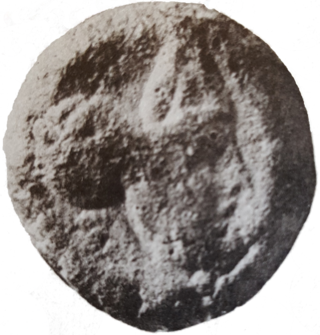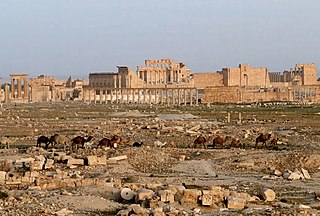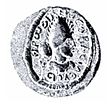
Septimia Zenobia was a third-century queen of the Palmyrene Empire in Syria. Many legends surround her ancestry; she was probably not a commoner and she married the ruler of the city, Odaenathus. Her husband became king in 260, elevating Palmyra to supreme power in the Near East by defeating the Sasanian Empire of Persia and stabilizing the Roman East. After Odaenathus' assassination, Zenobia became the regent of her son Vaballathus and held de facto power throughout his reign.

The Bahri Mamluks, sometimes referred to as the Bahri dynasty, were the rulers of the Mamluk Sultanate of Egypt from 1250 to 1382, following the Ayyubid dynasty. The members of the Mamluk ruling class were purchased as slaves (mamluks) and manumitted, with the most powerful among them taking the role of sultan in Cairo. While several Bahri Mamluk sultans tried to establish hereditary dynasties through their sons, these attempts were ultimately unsuccessful, with the role of sultan often passing on to another powerful Mamluk.

Septimius Odaenathus was the founder king (malik) of the Palmyrene Kingdom who ruled from Palmyra, Syria. He elevated the status of his kingdom from a regional center subordinate to Rome into a formidable state in the Near East. Odaenathus was born into an aristocratic Palmyrene family that had received Roman citizenship in the 190s under the Severan dynasty. He was the son of Hairan, the descendant of Nasor. The circumstances surrounding his rise are ambiguous; he became the lord (ras) of the city, a position created for him, as early as the 240s and by 258, he was styled a consularis, indicating a high status in the Roman Empire.

Izz al-Din Aybak was the first of the Mamluk sultans of Egypt in the Turkic Bahri line. He ruled from 1250 until his death in 1257.

Septimius Vaballathus was emperor of the Palmyrene Empire centred at Palmyra in the region of Syria. He came to power as a child under his regent mother Zenobia, who led a revolt against the Roman Empire and formed the independent Palmyrene Empire.
Mansa Jata, commonly referred to as Mari Jata II, possibly incorrectly, known in oral histories as Konkodugu Kamissa was mansa of Mali from 1360 to 1374. He was an ineffective ruler, and his reign, recorded by the contemporary North African historian Ibn Khaldun, marked the beginning of the decline of the Mali Empire.

The Palmyrene Empire was a short-lived breakaway state from the Roman Empire resulting from the Crisis of the Third Century. Named after its capital city, Palmyra, it encompassed the Roman provinces of Syria Palaestina, Arabia Petraea, and Egypt, as well as large parts of Asia Minor.
Owais al-Qarani, also spelled Uways or Owais, was a Muslim from South Arabia who lived during the lifetime of the Islamic Prophet Muhammad.
An-Nasir Yusuf, fully al-Malik al-Nasir Salah al-Din Yusuf ibn al-Aziz ibn al-Zahir ibn Salah al-Din Yusuf ibn Ayyub ibn Shazy, was the Ayyubid Kurdish Emir of Syria from his seat in Aleppo (1236–1260), and the Sultan of the Ayyubid Empire from 1250 until the sack of Aleppo by the Mongols in 1260.
Ṣāʿid al-Andalusī, in full Abū al-Qāsim Ṣāʿid ibn Abū al-Walīd Aḥmad ibn Abd al-Raḥmān ibn Muḥammad ibn Ṣāʿid ibn ʿUthmān al-Taghlibi al-Qūrtūbi, was an Arab qadi of Toledo in al-Andalus, who wrote on the history of science, philosophy and thought. He was a mathematician and scientist with a special interest in astronomy and compiled a famous biographic encyclopedia of science that quickly became popular in the empire and the Islamic East.
Abū Naṣr al-Fatḥ ibn Muḥammad ibn ʿUbayd Allāh ibn Khāqān ibn Abdallah al-Qaysī al-Ishbīlī, known as al-Fatḥ ibn Khāqān, was a 12th-century popular anthologist of al-Andalus.
Jamal al-Din Yusuf bin al-Amir Sayf al-Din Taghribirdi, or Abū al-Maḥāsin Yūsuf ibn Taghrī-Birdī, or Ibn Taghribirdi was an Islamic historian born in the 15th century in Mamluk Egypt. He studied under al-Ayni and al-Maqrizi, two of the leading Cairene historians and scholars of the day.

Palmyra is an ancient city in the eastern part of the Levant, now in the center of modern Syria. Archaeological finds date back to the Neolithic period, and documents first mention the city in the early second millennium BC. Palmyra changed hands on a number of occasions between different empires before becoming a subject of the Roman Empire in the first century AD.
Husam ad-Din Muhanna ibn Isa was the Arab lord of Palmyra and amir al-ʿarab under the Mamluk Sultanate. He served between 1284 and his death, but was dismissed and reinstated four times during this period. As the chieftain of the Al Fadl, a clan of the Tayy tribe, which dominated the Syrian Desert, Muhanna wielded considerable influence among the Bedouin. He was described by historian Amalia Levanoni as "the eldest and most senior amir" of the Al Fadl during his era.
Al Fadl were an Arab tribe that dominated the Syrian Desert and steppe during the Middle Ages, and whose modern-day descendants largely live in southern Syria and eastern Lebanon. The Al Fadl's progenitor, Fadl ibn Rabi'ah, was a descendant of the Banu Tayy through his ancestor, Mufarrij al-Jarrah. The tribe rose to prominence by assisting the Burids and Zengids against the Crusaders. The Ayyubids often appointed them to the office of Amir al-ʿarab, giving the Al Fadl emirs command over the Bedouin tribes of northern Syria. Their function was often to serve as auxiliary troops.
Abd al-Rahim ibn Ja'far ibn Sulayman al-Hashimi was a ninth century Abbasid personage and governor of the Yemen.
Khalīl ibn Aybak al-Ṣafadī, or Ṣalaḥ al-Dīn al-Ṣafadī (Arabic: صلاح الدين الصَّفديّ; full name - Ṣalaḥ al-Dīn Abū al-Ṣafa Khalīl ibn Aybak ibn ‘Abd Allāh al-Albakī al-Ṣafari al-Damascī Shafi'i. was a Turkic Mamluk author and historian. He studied under the historian and Shafi'i scholar, al-Dhahabi.
Abū ʿAbd Allāh Muḥammad ibn Ziyād, surnamed Ibn al-Aʿrābī ; a philologist, genealogist, and oral traditionist of Arabic tribal poetry. A grammarian of the school of al-Kūfah, who rivalled the grammarians of al-Baṣrah in poetry recital. He was famous for his knowledge of rare expressions and for transmitting the famous anthology of ancient Arabic poetry, Al-Mufaḍḍalīyāt.
Abū Bakr az-Zubaydī, also known as Muḥammad ibn al-Ḥasan ibn ‘Abd Allāh ibn Madḥīj al-Faqīh and Muḥammad ibn al-Ḥasan az-Zubaydī al-Ishbīlī, held the title Akhbār al-fuquhā and wrote books on topics including philology, biography, history, philosophy, law, lexicology, and hadith.

Kitāb al-ʿIbar is a 14th-century historical encyclopedia in seven volumes written by the Arab sociologist and historian Ibn Khaldun. Its prolegomenon, or introduction, is al-Muqaddima. Kitāb al-ʿIbar was also printed in Arabic under the title Tarīkh Ibn Khaldūn.












